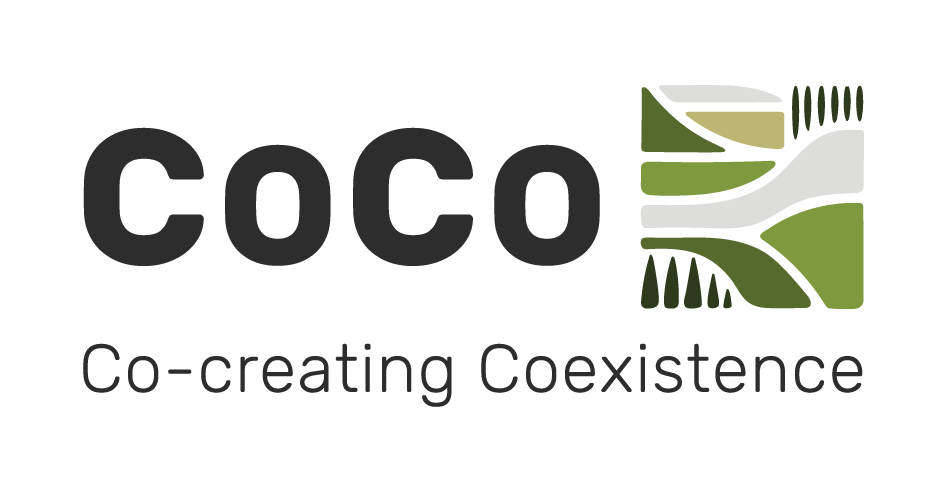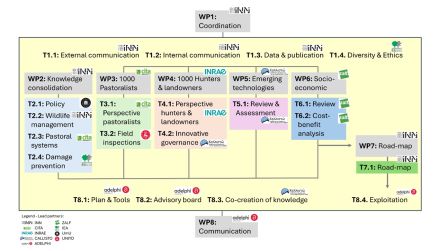
The CoCo project is based on a set of 20 specific tasks organised into 8 work packages, each of which plays a crucial role in addressing the interactions between pastoralism and wildlife management.
Two work packages run throughout the project: WP1, which focuses on project management and internal communication, and WP8, which deals with external communication, dissemination and exploitation, linking the project to the wider world. The remaining six work packages are dedicated to data collection, processing and integration of results.
In addition, there are a number of cross-cutting activities. One of these is a focus on gender and diversity, and the other concerns the use of a multi-actor approach to ensure the co-generation of a holistic form of knowledge.
Project Coordination
Work package 1, under the leadership of INN, focuses on managing and organising the entire project, both within the project team and with external funders. Key objectives include:
- maintaining communication with the European Commission,
- ensuring internal workflows and partner cooperation,
- developing and monitoring data management plans and publication strategies,
- and addressing gender, diversity, equality, and ethics issues.
Knowledge consolidation
Work package 2, led by INN with support from NINA, gathers and synthesises existing knowledge on policies and practices related to pastoralism, wildlife management, nature conservation, and other land uses. This involves:
- evaluating policies and practices,
- understanding the diversity of pastoral systems in different countries,
- and collecting the best practices for preventing damage to support informed decision-making and sustainable development.
The work involves reviewing existing literature, laws, and policy documents, and conducting interviews and workshops to gather more insights.
Effectivity of livestock protection strategies
Work package 3, which is led by CITA, is about the collection of detailed quantitative field data on livestock husbandry practices and livestock protection measures from 1000 herders and farmers across 12 European countries. This extensive fieldwork includes face-to-face interviews with herders and farmers, capturing insights from a wide diversity of pastoral systems currently in use across Europe. The goal is to evaluate how effective different strategies for dealing with wildlife damages are.
Stakeholder perspectives on needs and measures to manage conflicts
The objective of work package 4, led by INRAE , is the collection of quantitative and qualitative data from pastoralists, hunters, and landowners like farmers or foresters, to understand their views on wildlife-livestock interactions and management.
The goal is to explore different stakeholder perspectives on the state and management of the livestock-wildlife interface and associated conflicts, and to identify successful governance strategies for a best-practice roadmap. This work package builds on previous work by adding insights from hunters and landowners, using both qualitative and quantitative methods, and focusing on the social dimensions of these conflicts rather than just the economic impacts.
Emerging tools and technologies for rapid assessment and management of the wildlife-livestock interface
Under the leadership of CALLISTO, work package 5 looks at current and new technologies to find the best ways to use them together for managing wildlife and livestock interactions. Many technological solutions to wildlife damage reduction such as risk maps, AI tools, GPS livestock tracking, and robotic guardians, are being suggested to help reduce conflicts and promote coexistence. However, it's unclear if these technologies are practical or affordable for traditional farmers. The team reviews how effective these tools are and finds the best combinations to make them implementable, especially in traditional pastoral practices.
Socio-economic analysis of the wildlife – livestock interface
Work package 6, led by ZALF, explores the complex socio-economic relationship between wildlife and livestock. While the value of meat and milk can be quantified in money, other aspects like cultural significance and landscape maintenance require a broader view. The aim is to analyse current and new strategies to make both wildlife and pastoral systems more sustainable. This involves mapping the positive and negative impacts and creating a detailed classification of their interactions.
Developing a Roadmap to Coexistence
The aim of work package 7 is to transform the findings from previous research and modelling efforts into practical recommendations and guidelines. These are designed to integrate wildlife and pastoralism within multi-functional landscapes. The culmination of these efforts will be a comprehensive Roadmap to Coexistence, providing a holistic approach to balancing these interests. WP 7 is led by INN with support from NINA.
Co-creation, dissemination, exploitation and communication
Given the high interest and controversy surrounding wildlife and pastoralism interactions, work package 8, led by adelphi, seeks to navigate these dynamics by involving stakeholders in knowledge creation. The goal is to engage with stakeholders, end-users, and the public to enhance research quality and impact.
Key objectives include:
- developing a plan for sharing and using project results,
- creating multimedia communication tools,
and maintaining ongoing interactions with a Stakeholder Advisory Board, to foster genuine co-generation of knowledge.

Funded by the European Union. Views and opinions expressed are however those of the author(s) only and do not necessarily reflect those of the European Union or the European Research Executive Agency. Neither the European Union nor the granting authority can be held responsible for them.

